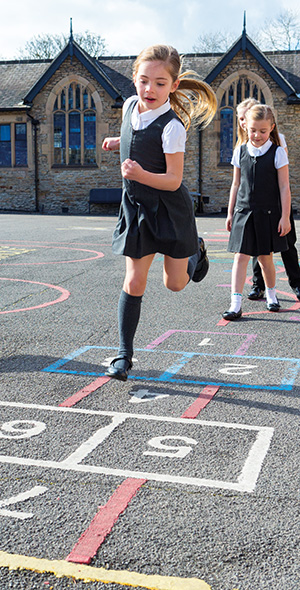Interpreting school results can be a confusing business. Charlotte Phillips finds out how to decipher the data
When it comes to choosing a school, that iceberg metaphor isn’t half apt. Visiting in person or online may give you a feel for the buildings, the grounds and the equipment, but what parents actually see when they’re choosing a school is about 10% of what life there is all about.

The bottom line is that it’s all about context. To be able to make an informed decision, it helps to know what the information you’re presented with can tell you and – more to the point – what it can’t. Many families start off with the results. In theory at least, they leave nowhere to hide. Either a school is successful or it’s not. With national league tables published online within days of the results coming out, parents are able to see not just how well the school is doing, but how it compares with others.
But whether the most recent results dazzle or disappoint, they are a snapshot in time, representing just one year in a school’s life – one chapter in an evolving story – and should be approached with caution, particularly as some schools don’t even appear in them, says John Attwater, principal of King’s Ely. “Not all schools are in the newspaper league tables – this is an opt-in process and many top schools decided some years ago not to take part, believing them to be highly misleading,” he explains.
And he stresses that league tables are, at best, “only one tool for helping to choose a school”. He adds: “All are focused only on exam results at GCSE or A-level. They measure averages only, so broadly speaking, a school towards the top of the league tables will tend to be academically highly selective (their average child will be a high-flyer), while one lower down will recruit from a broader range of ability, but may still contain a large number of high-flyers and teach excellently.”
If you’ve got a mixed cohort, schools achieving above the national average are doing something pretty right
For some children, an unashamedly academic environment can be just what they need. For others, including those who may be very able, a more mixed intake will be a better fit. “Don’t get the wrong impression from those schools that don’t have a high bar entrance exam and slightly lower GCSE scores,” says Richard Settle, head teacher at Sancton Wood School. “If you’ve got a mixed cohort, schools that are achieving above the national average are doing something pretty right,” he says.
If results are OK-ish, but in gentle decline compared with a few years back, parents should be asking why. Plenty of schools will have a blip that could be down to a revamped subject, a new syllabus or even variations in pupils’ ability. In smaller schools with correspondingly diminutive year groups, it can take just a few pupils in a marginally weaker cohort to do rather worse than anticipated, so results show a significant dip – only to shoot up again the following summer when a higher-achieving group of pupils sit their exams. “Bear in mind that if you’ve got a school with one or two form entry, it only needs one or two students not to do so well to massively skew a league table standing, so be careful on that as well,” warns Richard Settle.

And if you’re still none the wiser (schools can be surprisingly reticent about the amount of detail they go into), it’s worth asking for a breakdown of grades for each subject. Most schools will be glad to share this information, as well as telling parents the number of candidates taking the exams in each subject. Again, it’s all about context. If one pupil takes GCSE German and gains a top grade, it will show up as 100% – but tell you almost nothing about how strong modern languages teaching is at the school. Again, seek comparisons with previous years. That side-by-side column will tell it like it is.
Ask about progress, too. Many schools assess pupils – state schools are required to do so – at regular intervals. Most schools now measure ‘value added’ – aka the way pupils perform against others of similar raw ability, so ask whether and how this is done, says John Attwater. Their goal is to improve on the raw material they start off with, so children do better than you’d have expected them to. How much better can vary substantially, but good teaching that challenges children and inspires a real love of learning can make an enormous difference.

Seeing where that learning takes place can also give families a nice, warm feeling. Nothing beats seeing just where the school is investing its money, from high-tech science labs (clinical white with splashes of primary colours is a wish list must-have for many a department head these days), to multisports pitches and multilevel libraries.
Context applies here, as well. There’s no doubt that new buildings (always photographed with all the lights on, ideally across a lake at sunset), can be hugely impressive. The canny parent, however, will want to know who gets to use them and when. A new theatre that stands empty for most of the time because only the super-talented are chosen for the mega summer production might not be quite the showstopper it first appears. And take a second look at that fabulous library. Are there gaps in its shelves or are they stuffed full of immaculate-looking books? If so, where are the queues of pupils arriving in their dozens to relax, read and borrow?
It’s also important to look at how well grounds and buildings are looked after by staff and pupils, says John Attwater. “Clearly well-used and loved, even if that means looking worn by the summer term and waiting for annual maintenance, is much better than pristine and unused. But there’s a difference, too, between well-used and neglected or abused: a school and its pupils’ attitude to their environment often reflects their attitude to each other.”
Then there’s the location. Countryside schools may offer dreamy tree-lined drives, listed buildings and green acres of fields stretching into the distance. City centre establishments, on the other hand, pride themselves on their ability to couple an urban setting with unbelievably imaginative architecture. Good design can take you a long way when space is at a premium.
It is critical the school choice works well for family life, or it will be a source of stress
City centre or fairytale idyll, it’s worth doing a reality check and seeing how well the school gels with families’ lifestyles. Given that more parents than ever before are dual earners with full-time jobs, that last-minute dash to collect an unwell child or drop in that missing violin, homework or permission slip could end up feeling a lot more like a Brothers Grimm special than The Enchanted Wood. “It is critical the school choice works well for family life, otherwise it will always be a source of stress, which will inevitably be transmitted to the child,” points out John Attwater. “Location and accessibility are therefore important, whether for day or boarding schools.”
It’s also sensible to get an insight into a school’s culture and see whether – as the song has it – you feel ‘one of the family’. It’s a fair bet that all schools’ literature for prospective parents will stress the welcoming, friendly vibe. Some have a highly distinctive ethos. St Christopher School, an independent school based in Letchworth Garden City, for example, prides itself on its reputation as ‘not your typical independent school’, where pupil happiness stems from a focus on the individual.

“It’s important when you look round and talk to people to see if you feel comfortable,” says Richard Settle. “If you feel uncomfortable and slightly out of place, the chances are your child is going to as well.”
If you want to know how it would feel to be a school family and check the school walks the walk, try to speak to current families – some have parent ambassadors who are always happy to talk to prospective parents. Sancton Wood will do its best to match you with a family who joined in similar circumstances – relocating at short notice, for example.
Ask what they – and their children – like about the school. Find out if they have any niggles. Minor (the odd duff school lunch, for example) is as you’d expect: no school, after all, is perfect. Major issues – many unfilled key teaching posts, sudden staff departures, consistently poor communications with parents – deserve further investigation.
Finally, but most importantly, ensure that when you’re considering a school, you’re always doing it from the perspective of your child. And that means considering the whole picture, says John Attwater. “In the same way most people wouldn’t pick a spouse from a league table of their statistics, and would probably rightly regard someone with suspicion who was keen to be measured in that way, choosing a school for your child is a personal matter to them, and you really do owe it to them to do a proper matching process.”

